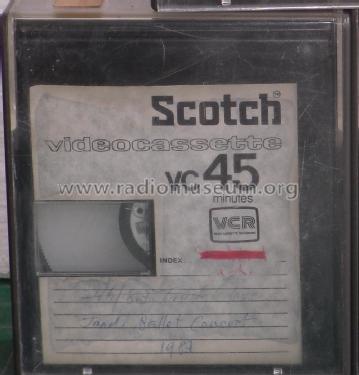Scotch Video Cassette Recording VCR, VCR-LP (Longplay)
3M, Lake Superior
- Produttore / Marca
- 3M, Lake Superior
- Anno
- 1971 ?
- Categoria
- Miscellanea (Altro, Varie) - vedere nelle note
- Radiomuseum.org ID
- 343858
- Gamme d'onda
- - senza
- Particolarità
- Nastro o cassetta, formato speciale
- Tensioni di funzionamento
- Alimentazione non richiesta
- Altoparlante
- - - Nessuna uscita audio.
- Materiali
- Plastica (non bachelite o catalina)
- Radiomuseum.org
- Modello: Scotch Video Cassette Recording VCR, VCR-LP - 3M, Lake Superior
- Forma
- Diverse forme (descritte nelle note).
- Dimensioni (LxAxP)
- 130 x 41 x 145 mm / 5.1 x 1.6 x 5.7 inch
- Annotazioni
-
This page is for all Scotch 3M Video Recording Cassettes (VCR), with type designations like VC-30, VC-45 and VC-60, and irrespective where they were manufactured.
Scotch VCR cassettes were at least manufactured in the USA.The VCR cassette was first used in the VCR Video Cassette Recorder N1500, in 1977 followed by the first VCR-Longplay Recorders N1700 and N1702. The first Grundig model was VR2000 Color from 1971, followed by BK2000 in 1972.
The indicated weight refers to the VC-60 cassette. The cassettes contain 1/2" tape.
Please do not modify this page. Only upload pictures with all information in the picture legend!
Bitte nur Bilder hochladen, alle Informationen/Daten in die Bildlegende.
History (source Wikipedia):
Video Cassette Recording (VCR) is an early domestic analog recording format designed by Philips. It was the first successful consumer-level home videocassette recorder (VCR) system. Later variants included the VCR-LP and Super Video (SVR) formats.
The VCR format was introduced in 1971, just after the Sony U-Matic. Although at first glance the two might appear to have been competing formats, they were aimed at very different markets. After failing as a consumer format, U-matic was marketed as a professional television production format, whilst VCR was targeted particularly at educational but also domestic users.
Home video systems had previously been available, but they were open-reel systems and were expensive to both buy and operate. They were also unreliable and often only recorded in black and white. The VCR system was easy to use and recorded in colour but was still expensive.
Geschichte (Quelle Wikipedia):
Das VCR-System („Video Cassette Recording“) ist ein frühes analoges Farb-Heimvideorekordersystem von Philips aus dem Jahr 1971. Es war das erste kommerziell erfolgreiche Video-Kassettenformat für den Heimgebrauch.
Das Videoband hatte seine Laufbahn wie das Audio-Tonband zuerst als loses Rollenband, welches auf Spulen aufgewickelt war und beim Auflegen auf das Videogerät an einer Leerspule eingefädelt werden musste, begonnen. Nun überlegte man sich – ebenso wie beim Audioband – ein Kassettensystem zu entwickeln, welches das Einlegen vereinfacht, weil dadurch vor allem das umständliche Einfädeln entfällt und das Band nicht mit den Fingern berührt werden muss.
In den 1970ern entwickelten Grundig und Philips ihr bereits eingeführtes, noch auf der Technik der offenen Bandspulen beruhendes Schwarzweiß-System weiter. Dabei wurden die Spulen mit einem Kassettengehäuse versehen, in dem sie übereinander angebracht waren. Die Kassetten waren ungefähr so groß wie CDs, nur deutlich dicker. Dies ermöglichte recht große Spulen in einem relativ kompakten Format.
- Peso netto
- 0.410 kg / 0 lb 14.4 oz (0.903 lb)
- Autore
- Modello inviato da Bernhard Nagel. Utilizzare "Proponi modifica" per inviare ulteriori dati.
- Altri modelli
-
In questo link sono elencati 18 modelli, di cui 18 con immagini e 0 con schemi.
Elenco delle radio e altri apparecchi della 3M, Lake Superior
Collezioni
Il modello Scotch Video Cassette Recording fa parte delle collezioni dei seguenti membri.
